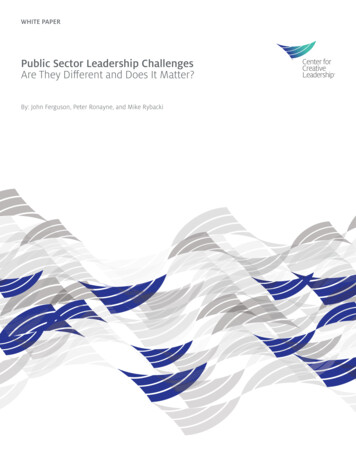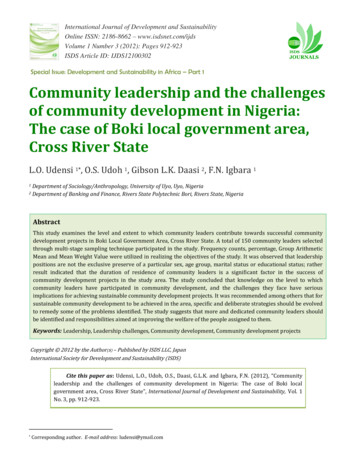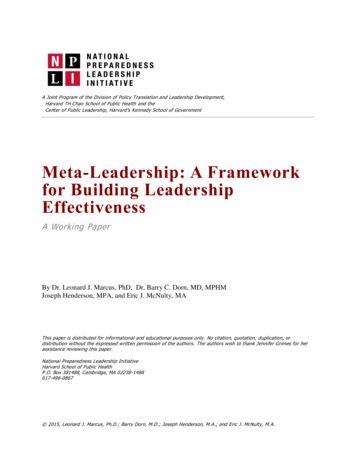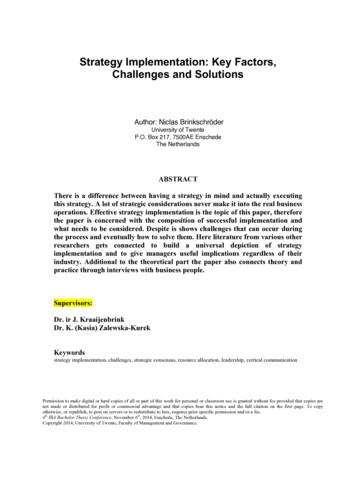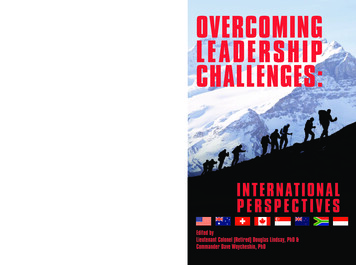
Transcription
OVERCOMING LEADERSHIP t Colonel ( Retired ) Douglas Lindsay, PhD &Commander Dave Woycheshin, PhDINTERNATIONALPERSPECTIVESEdited byLieutenant Colonel (Retired) Douglas Lindsay, PhD &Commander Dave Woycheshin, PhD
Previous International MilitaryLeadership Association (IMLA)books published by CDA PressIn Pursuit of Excellence:International Perspectives of Military Leadership (2006)Strategic Leadership Development:International Perspectives (2007)Professional Ideology & Development:International Perspectives (2008)Decision-Making:International Perspectives (2009)Military Ethics:International Perspectives (2010)Developing the Next Generation of Military Leaders:Challenges, Imperatives and Strategies (2011)Threats to Military Professionalism:International Perspectives (2012)The Comprehensive Approach to Operations:International Perspectives (2013)Adaptive Leadership in the Military Context:International Perspectives (2014)
OVERCOMINGLEADERSHIPCHALLENGES:I N T E R N AT I O N A LPERSPECTIVES
canadab OVERCOMING LEADERSHIP CHALLENGES: INTERNATIONAL PERSPECTIVES
OVERCOMINGLEADERSHIPCHALLENGES:I N T E R N AT I O N A LPERSPECTIVESEdited byLieutenant Colonel (Retired) Douglas Lindsay, PhD& Commander Dave Woycheshin, PhD
Copyright 2015 Her Majesty the Queen, in Right of Canada, as represented bythe Minister of National Defence.Canadian Defence Academy PressPO Box 17000 Stn ForcesKingston, Ontario K7K 7B4Produced for the Canadian Defence Academy Pressby 17 Wing Winnipeg Publishing Office.WPO31216Library and Archives Canada Cataloguing in PublicationOvercoming leadership challenges : international perspectives /edited by Lieutenant Colonel (Retired) Douglas Lindsay, PhD& Commander Dave Woycheshin, PhD.Produced for the Canadian Defence Academy Press by17 Wing Winnipeg Publishing Office.Electronic monograph in PDF format.Issued also in printed form.Issued by: Canadian Defence Academy.Includes bibliographical references and index.ISBN 978-0-660-02901-6Cat. no.: D2-358/2015E1. Command of troops. 2. Leadership. 3. Military doctrine.I. Lindsay, Douglas II. Woycheshin, David E. (David Earl), 1961III. Canadian Defence Academy IV. Canada. Canadian Armed Forces.Wing, 17UB210 O94 2015Printed in Canada.1 3 5 7 9 10 8 6 4 2355.3'3041C2015-980038-2
The views expressed in this publication are entirely those of the authors anddo not necessarily reflect the views, policy or position of the Government ofCanada, the Department of National Defence, the Canadian Armed Forcesor any of its subordinate units or organizations.
canadaf OVERCOMING LEADERSHIP CHALLENGES: INTERNATIONAL PERSPECTIVES
ACKNOWLEDGEMENTSOvercoming Leadership Challenges is the tenth publication by the International Military Leadership Association. For the past ten years, this grouphas consistently produced high-quality publications on a wide range ofrelevant topics in military leadership. This volume identifies many keychallenges faced by military leaders and offers suggestions for overcomingthese problems.It is important to recognize the ongoing support of Military PersonnelGeneration (MILPERSGEN) and the Canadian Defence Academy Pressfor this series of publications. In particular, our gratitude and thanks goto Melanie Denis of MILPERSGEN for her long term help and supportin producing these volumes. Our thanks also go to Marie-Josée Landry,who has taken over Melanie’s duties. We must also express our gratitudeto the 17 Wing Publishing Office in Winnipeg, Manitoba, for consistentlyproducing a high-quality, professional product.
canadah OVERCOMING LEADERSHIP CHALLENGES: INTERNATIONAL PERSPECTIVES
TABLE OF CONTENTSFOREWORD. iiiCHAPTER 1NEW ZEALANDLeadership: Simplifying the ComplexCommander Mark Meehan . 1CHAPTER 2SINGAPOREUnderstanding the Process of Military Leaders’Development as ProfessionalsSenior Lieutenant Colonel Daniel Siew Hoi Kok. 29CHAPTER 3UNITED STATESThe Pseudoscientific Leader: Do Bad Leaders Endure byUsing Pseudoscientific Thinking?Craig A. Foster, PhD, andJennifer A. Clarke, PhD. 67CHAPTER 4SWITZERLANDThe Problem of Evil Leadership:Conceptual Aspects and Visualized NarrativesFlorian Demont, PhD, and Michael Jager. 89CHAPTER 5UNITED STATESMilitary Leadership and Administrative EvilGeorge E. Reed, PhD, andLieutenant Colonel James M. Dobbs, PhD. 105CHAPTER 6UNITED STATESSituational Obstacles to Enacting TransformationalLeadership in Military OrganizationsLieutenant Colonel Daniel J. Watola, PhD,Lieutenant Colonel (Ret'd) Douglas R. Lindsay, PhD,and Lieutenant Colonel Robert D. Reimer. 121OVERCOMING LEADERSHIP CHALLENGES: INTERNATIONAL PERSPECTIVES i
TABLE OF CONTENTSCHAPTER 7CANADAGetting Ready to Change: What Leaders Can Do toFoster Change ReadinessMartin Yelle, PhD, and Martin Lauzier, PhD. 143CHAPTER 8AUSTRALIAOperating in the Age of 24/7 Media Coverage:Challenges for Strategic LeadersBrian Agnew. 159CHAPTER 9INDONESIACross-Generational Leadership: Challenges in Leadingthe Indonesian Army as a Modern OrganizationLieutenant Colonel Frega Ferdinand Wenas-Inkiriwang,Lieutenant Colonel Ardisutopo Endro Tjahjono, andColonel Eri Radityawara Hidayat, PhD. 167CHAPTER 10UNITED STATESThe Dynamics of Rules, Learning, andAdaptive Leadership: Inspirations andInsights from the United States Marine CorpsJerry Guo and Mie Augier, PhD. 185CHAPTER 11SOUTH AFRICAWhen Military Leaders Differ from Their Political Leaders:Overcoming Leadership ChallengesColonel Piet C. Bester, D Phil, andMajor Anita G. du Plessis. 203CONTRIBUTORS. 227iiGLOSSARY. 235INDEX. 237 OVERCOMING LEADERSHIP CHALLENGES: INTERNATIONAL PERSPECTIVES
FOREWORDI am pleased to introduce Overcoming Leadership Challenges, the tenth volume of the International Military Leadership Association (IMLA) seriespublished by the Canadian Defence Academy Press. Established in 2005,the IMLA has provided a forum for military leadership researchers, academics, and members of military leadership institutes to collaborate on awide variety of military leadership projects. The IMLA has recently beenformally recognized as a permanent Working Group of the InternationalMilitary Testing Association. This publication is one of the tangible outcomes of this fruitful and vital collaboration.Overcoming Leadership Challenges addresses both perennial leadershipchallenges and challenges that come from today’s operational environment.Despite efforts to recruit, select, train, and develop the best leaders forour militaries, there have always been good leaders and bad leaders. Thisvolume includes a number of chapters that help explain and understandbad leaders and evil leaders. A chapter on pseudoscientific thinking offers a means to understand and deal with bad leaders. The volume also includes positive approaches to overcoming leadership challenges, includingsurmounting obstacles to enabling transformational leadership and facilitating the development of military leaders as professionals.Overcoming Leadership Challenges also addresses the challenges faced byleaders today. One example is the shift in the use of social media by different generations of leaders. Leaders must understand how and when to usethe convenient, but indirect, forms of communication that social mediaprovide, and when to use “old-fashioned” face-to-face communication. Social media can also be used to a military organization’s advantage, as demonstrated in the case study of Australia’s response to the search for MalaysiaAirlines Flight 370. Finally, the volume includes a chapter on overcoming aperennial problem that seems particularly prevalent today: how leaders canprepare their subordinates to deal with organizational change.OVERCOMING LEADERSHIP CHALLENGES: INTERNATIONAL PERSPECTIVES iii
FOREWORDThe IMLA continues to demonstrate its relevance to furthering the understanding of the many facets of military leadership. I commend the efforts of theauthors, editors, and publishing staff in producing this volume and Iunequivocally support the continued publication of the IMLA series by theCanadian Defence Academy Press.J.G.E. TremblayMajor-GeneralCommanderMilitary Personnel Generationiv OVERCOMING LEADERSHIP CHALLENGES: INTERNATIONAL PERSPECTIVES
CHAPTER 1CHAPTER 1Leadership: Simplifying the ComplexCommander Mark Meehan*IntroductionIn 2011, the New Zealand Defence Force (NZDF) recognized the advantagethat improved leadership development could provide, both at the individual and the organizational level. However, like many other organizations,despite having discrete, isolated, touch points of leadership developmentthroughout its organization, a comprehensive system of leadership development across the full spectrum of the organization did not exist. The first,and in practice the most straightforward, exercise was to establish a leadership development framework. Semi-structured interviews and leadershipbehaviour card sorts were conducted at every level of the organization. Thisinformation was analyzed and compared against international benchmarksto provide a clear and coherent picture of what leadership success lookedlike, behaviourally, at every leadership level in the NZDF. From this, theNZDF Leadership Development Framework (LDF) was created. While theidentification of what leadership success looked like for the NZDF was relatively simple, the true challenge remained: how to support the understanding and development of leadership from both a theoretical and practicalperspective within the organization.In order to support leadership development, the NZDF implemented itsLeadership Development System (LDS). For the LDS to be effective, a clearunderstanding of what leadership is and how it is developed was required.Whilst the NZDF was advanced in its thinking, regarding establishing theLDF and providing a very clear picture of the behaviours of a successful leader, an understanding of how these would be developed in its members wasstill in a nascent stage. While it was understood that certain intangible qualities existed in a successful leader, (i.e., they had “soft” skills that supportedtheir engagement with those they led), how could they articulate these skillsand place them alongside the “hard” skills required to be an effective leader*The views expressed in this chapter are those of the author and do not reflect those of the NewZealand Defence Force or the New Zealand Defence Force Institute for Leader Development.OVERCOMING LEADERSHIP CHALLENGES: INTERNATIONAL PERSPECTIVES 1
NEW ZEALANDin the military? Attempting to provide this clarity exposed a “leadershipindustry” that imparts a myriad of theories, each with supporting models.While all of these theories are presented with the aim of unravelling the complexity of leadership, and despite the efforts of a leadership industry, a lack ofclarity regarding leadership still exists. This paper has been generated for twoprimary reasons: to support the establishment of the LDS and, perhaps moreimportantly, to provide wider clarity and some points to support the widerunderstanding of leadership and leadership development.In 1959, Bennis wrote, “of all the hazy and confounding areas in social psychology, leadership theory undoubtedly contends for top nomination. And,ironically, probably more has been written and less is known about leadership than about any other topic in the behavioural sciences.”1 It can be arguedthat more than half a century later, Bennis’ statement, for the most part, remains applicable. The neoteric nature of the leadership industry is actuallyundermining the understanding of leadership and leadership development.It is not suggested that this is a reflection of any attempt to disguise the issue,nor is the issue isolated to the work of any individual, but the issue is reflective of the industry itself. An industry has developed comprising commercialentities,2 bringing their promises of unravelling the conundrum of the “artand science of leadership.”3 In an attempt to bring their points of differenceto the leadership milieu, most theorists have in fact added complexity, notelucidated the challenges.The current state of the understanding of leadership is defined by Kellerman,in her 2012 work The End of Leadership.4 Kellerman delivers a coherentdialogue describing an industry that has developed around leadership as aconstruct. An argument is put forward regarding the impact that changes insocietal norms and advances in technology have had on leadership. According to Kellerman, the requirements of leadership are now different due to thenew complex environment. Kellerman is not alone in her thinking: notabletheorists, such as Hazy, Lichtenstein, Uhl-Bien, Marion, Gardner, Pearce andConger,5 all identify with the new and complex leadership milieu. Furthermore, these theorists also consider that the current leadership environmentrequires new perspectives through which to view and resolve the potentialnew challenges. While the irony of the self-fulfilling prophesy is not missedby some, on the whole, this perspective in turn supports and feeds the leadership industry.62 OVERCOMING LEADERSHIP CHALLENGES: INTERNATIONAL PERSPECTIVES
CHAPTER 1The Goals of this ChapterAt its core, leadership is about “simplifying the complex.”7 This chapter willdo this by exploring the fundamental core of leadership. The industry that hasevolved around understanding and developing leadership argues that today’sleadership environment is different, new, and complex. It will be argued thatthis is not the case; the environment within which leaders operate has alwaysbeen constantly changing. Furthermore, the challenge of leadership is notany different now than it has ever been. Leaders have always had to respondto new and complex environments, and will continue to have to respond tothese environments. It is proposed that ensuring successful relationships between leaders, followers, and all actors involved in the achievement of thesuccess of a leadership event is the heart of leadership. This chapter will highlight that despite the efforts of the leadership industry, an unnecessary lackof clarity or understanding still exists in the field of leadership. This chapterwill explore the current understanding of leadership, and its development, byaddressing three questions:Question 1: Does confusion still exist around what leadership is?Despite the plethora of studies on the subject, it is posited that confusion stillexists around what exactly leadership is. Significant research has been conducted, and continues to be conducted, on the subject without any significantconsensus being achieved. However, this chapter will show that clarity canbe established.Question 2: Is the 21st century leadership environment more complex?It will be argued that the current lens through which leadership is viewedis in fact adding complexity, making the role of leading more challenging.As each new leadership era commences, new lenses through which to viewthe issue comes to the fore. In answering this question, some fundamentalflaws that have occurred in trying to elucidate leadership challenges will beexposed. Consideration of this question will build on the foundations laidexploring question one and support simplifying the complex.Question 3: How can the understanding of leadership, and its development, besimplified?The challenge will be considered from a humanistic approach. It will explore what is at the heart of leadership: human interaction. While the continued exploration of theory brings greater understanding, this explorationneeds to be based on solid foundations. The discussion provided to answerOVERCOMING LEADERSHIP CHALLENGES: INTERNATIONAL PERSPECTIVES 3
NEW ZEALANDthis question will support individual and organizational development ofleadership capacity.Through the exploration of these questions, it will become clear that the industry that has risen to support the understanding of leadership has, to anextent, proved counterproductive. The apparent unabated desire of theoriststo bring something new to leadership research and add to the leadershiplexicon has not, on the whole, supported leadership development. Practitioners of leadership are sufficiently challenged just by leading, without being required to come to terms with a seemingly never-ending supply of newleadership models and constructs. This chapter will argue that paring theunderstanding of leadership back to its most basic premise of human interaction should be the basis to build upon. While this approach is not radical,it is counter to the many new layers and lenses through which to view thechallenge of understanding leadership. It will be argued that this approachto supporting the understanding of leadership and to developing leadershipcapacity will better serve leadership as a whole.Question 1: Does confusionstill exist around what leadership is?First we must define leadership. Or must we?Leadership understanding, and its associated definitions, has movedthrough many epochs and we are now moving through yet another. Notable leadership theorists, such as Stogdill, Rost, Bass and Northouse, haveall explored the different lenses through which leadership has historicallybeen viewed.8 Each has provided similar chronologies of how the characterization of leadership has altered since its exploration commenced at theturn of the 20th century. Distinct leadership taxonomies have been identified in each decade from the 1920s through to the 1990s.9 The advent of thenew millennium brought with it a new lens of complexity through whichto attempt to unravel the leadership conundrum. The lens through whichleadership is explored keeps changing, attempting to bring a new perception of clarity to the issue. However, despite significant robust research efforts into the subject, the elucidation and clarity of defining leadership doesnot appear to have been gained.10To understand leadership and expand the knowledge of leadership, first it isnecessary to define it. Or is it? Whetten’s work,11 “What Constitutes a Theoretical Contribution,” is recognized as a model of how to explore theory.124 OVERCOMING LEADERSHIP CHALLENGES: INTERNATIONAL PERSPECTIVES
CHAPTER 1Whetten identifies four key elements required in a body of research: the firstthree of these are the what, the how, the why; the fourth component is actually made up of a group of three elements: the who, where and when. Unsurprisingly, Whetten identifies that establishing what is being explored is anunderpinning requirement of research, with the what being the “variables,constructs [or] concepts” to be tested or expanded upon. Recognizing theimportance of the theoretical underpinning of defining what leadership ishas not been missed by some within the academic community.13 However,establishing what leadership is, to be able to explore it against Whetten’s theoretical model, has proved challenging.In 1974, Stogdill published his review of the definition of leadership from the1920s through to the 1970s.14 This review of 221 definitions failed to drawconsensus on a singular definition of leadership. This is a failing in the theoretical exploration of leadership, looking for a black or white, or binary, answer to a challenge in human nature. It should be accepted that sometimesthe perfect answer just does not exist. If one were to explore the definition ofany word, selected at random, across multiple dictionaries, would the definition be exactly the same? However, the essence of the definition would bethe same, allowing for individual personalization. This more pragmatic approach to developing the understanding of leadership has been missed bysome theorists.The challenge of the plethora of leadership definitions was recognized byBass, who acknowledged a “surfeit of definitions of leadership.”15 The pragmatic approach to defining leadership is captured by Bass, who states thatthere are as many definitions of leadership as there are people consideringwhat leadership means to them. Bass’s point is that leadership is a very personal thing. It could be argued that, as the understanding of leadership developed, finessing of its definition occurred. Under different circumstances thiscould be considered appropriate and a natural progression. However, if oneconsiders this in conjunction with the significant changes that have occurredin the understanding of the leadership construct, the argument is invalid.Analysis of leadership as a field of study to support its understanding and development did not truly commence until the early 20th century.16 As the fieldof study developed, the predominant focus was placed on individuals andtheir roles as leaders. It was during this phase that leadership was exploredalmost exclusively through the “heroic conceptualization”17 lens of the leader.18This lens spurred the associated “great man” theory which evolved into themore general concept of trait theory. These theories were popularized in an attempt to help leaders recognize what they should “look like” if they were to beOVERCOMING LEADERSHIP CHALLENGES: INTERNATIONAL PERSPECTIVES 5
NEW ZEALANDsuccessful.19 The popularity of trait theory waned, largely as a result of the 1948work of Stogdill.20 Not dissimilarly to his later work reviewing the definition ofleadership, Stogdill called into question the trait construct, due to the inabilityof experts to reach universally accepted traits linked to effective leadership.The reductionist approach to study is not applicable to understanding leadership. While total agreement on defining leadership may not have beenachieved, advances in understanding leadership have occurred. This can berecognized through how leadership has historically been explored, initiallybeing considered solely through the lens of the leader to a more holistic approach, considering all of the actors involved in the leadership event. Despitethe lack of agreement on a definition of leadership, a greater understandingof the factors impacting leadership has clearly been developed. The challengefor theorists is to look at the bigger picture, rather than becoming consumedwith theoretical perfection. Stogdill’s review of trait theory undermined thisapproach’s academic credibility, but the role human traits play in leadershipand understanding human interaction still remains valid.21The Leadership Construct:Leading versus LeadershipFurther complicating issues in defining leadership arise due to the variabilityin how the leadership construct is considered. At the most basic level, leadership is very personal when looked at through the leader-follower relationship.At the other end of the conceptualization spectrum, leadership can be lookedat through the organizational context. Bass identifies 20 different constructsunder which leadership could be considered, from the simplistic constructof a “leader as a symbol,” “leadership as a process,” through to more abstractconstructs, such as “leadership as the initiation of structure” and “leadership as the making of meaning.”22 This attempt to capture what leadership isshould not to be confused with defining leadership; it is an additional levelof complexity. In his review of Bass’s earlier work, Washbush comments thatdue to the nature of leadership, the crux of leadership is what it is to those(i.e., each individual) who are considering it.23 Much as is the case with thevariations in defining leadership considered previously, Washbush considersit appropriate that “we are all free to define the term to suit our own needs.”24Bass recognizes the situational nature of leadership and that “the definitionof leadership should depend on the purposes to be served.”25In order to elucidate the complex leadership challenge purportedly faced bythe 21st century leader, it is necessary to unravel the role and requirements of6 OVERCOMING LEADERSHIP CHALLENGES: INTERNATIONAL PERSPECTIVES
CHAPTER 1a leader, and to distinguish this from the task of leadership. Bass’s 20 domainsof leadership provide a robust explanation of leadership context, but moresimple models can be applied. Friedrich et al.26 reference the work of Yukl27in linking leadership to three archetypes: leadership can be considered fromthe perspective of a person, through the lens of a role, or as required by aprocess. However, this can be reduced even further to two archetypes, that ofthe person (the leader), and the process (leadership).The simple construct of two leadership archetypes, that of the person (theleader) and that of the process (leadership), can provide the clarity to leadersthat is currently missing in the leadership industry. Schruijer and Vansina28argue for the uncomplicated construct, and their work is not incongruouswith that of Yukl. If it is considered that Yukl’s role of the leader has to befilled by a person, this model is valid. Friedrich and colleagues highlight thework of Gronn29 when identifying that “leadership is a complex process inwhich the behavioural roles that often fall under the leadership umbrella maybe taken up by different individuals.”30 The work of Schruijer and Vansinafurther supports the argument that the function of leadership does not haveto be fulfilled by a singular person, and that the function can be shared.31This concept is reinforced by the shared leadership models, most recently putforward by Pearce and Conger32 (this is not a new construct, a point that willbe expanded further in this chapter).Is Leadership So Hard to Define?In 2004, the GLOBE Project33 provided a definition of leadership that acts asa solid foundation for building the understanding of leadership. At the 2004Calgary GLOBE Project symposium, an international body of social scientists, led by House, considered the definition of leadership. They included thedefinitions of leadership from Stogdill, Bass, and Yukl, referenced previously.They considered the roles associated with those affected by acts of leadership,including leaders, followers, and groups or organizations, and how leadership is manifested, through its impact and influence. Furthermore, the symposium considered the impact of a leader’s ability in motivating individuals,and the effect of this on the required outcome. The GLOBE symposium ultimately defined leadership as “the ability to influence, motivate, and enableothers to contribute to the effectiveness and success of the organizations ofwhich they are members.”34 With this simple definition, Whetten’s first component of theoretical research can be considered established.35 Furthermore,and perhaps more importantly, this definition provides a foundation uponwhich to develop a greater understanding of leadership.OVERCOMING LEADERSHIP CHALLENGES: INTERNATIONAL PERSPECTIVES 7
NEW ZEALANDLeadership is Much More thanJust a DefinitionWhile the lens through which leadership is viewed has changed, the underpinning components of leadership, or what leadership intrinsically is, havenot. Each definition of leadership recognizes the role of the leader, for itis the leader that is ultimately responsible for the success of the leadershipevent.36 It should not be assumed that the role of the leader is fixed or evenpre-determined; the role can be contingent on the circumstances. The construct of leadership is not a result of leaders or theorists viewing and nowunderstanding leadership through the lens of Complex Adaptive Systems(CAS). If a leader exists by the very nature of a leadership relationship then somust followers, or those impacted by the actions and decisions of the leader.The various leadership constructs recognize that the leader’s role is to elicitoutcomes from an interaction. For this to occur, the leader has to have someform of effect or influence on the event and on those involved in the event.However, the leader does not operate in isolation; they interact with all thoseinvolved in the event.37 The leader’s influence is not just a one-way flow. Allthose involved in the event influence the outcome; the leader influences followers and in turn followers influence the leader. Similarly, all other players involved in the outcome play their part and impact outcomes. The onlyabsolute in the leadership construct is the reliance on influence; the abilityto influence is impacted by the leaders, followers, and others involved in theleadership event.Should Confusion Still Exist AroundWhat Leadership Is?Regardless of the construct through which leadership is considered, theGLOBE definition provides a solid basis on how to consider leadership.The constant rehashing of the definition of leadership, in an attempt to getagreement between theorists, adds no value to leadership development.Irrespective of whether leadership is examined through each of Bass’s 20leadership constructs, Yukl’s three archetypes, or through more contemporary constructs, such as “Shared Leadership,”38 “Authentic Leadership,”39 or“Complexity Leadership Theory,”40 leadership is, and will remain, “the abilityto influence, motivate, and enable others to contribute to the effectiveness andsuccess of the organizations of which they are members.” Clarity regardingwhat leadership is could and should exist. Why then does a lack of consensusexist in the leadership industry? The argument of theorists is that today’s8 OVERCOMI
NZDF Leadership Development Framework (LDF) was created. While the identification of what leadership success looked like for the NZDF was rela-tively simple, the true challenge remained: how to support the understand-ing and development of leadership from both a theor



